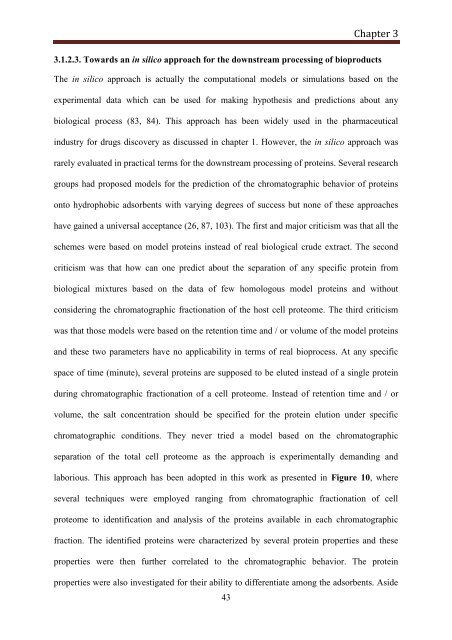Thesis final - after defense-7 - Jacobs University
Thesis final - after defense-7 - Jacobs University
Thesis final - after defense-7 - Jacobs University
Create successful ePaper yourself
Turn your PDF publications into a flip-book with our unique Google optimized e-Paper software.
Chapter 3<br />
3.1.2.3. Towards an in silico approach for the downstream processing of bioproducts<br />
The in silico approach is actually the computational models or simulations based on the<br />
experimental data which can be used for making hypothesis and predictions about any<br />
biological process (83, 84). This approach has been widely used in the pharmaceutical<br />
industry for drugs discovery as discussed in chapter 1. However, the in silico approach was<br />
rarely evaluated in practical terms for the downstream processing of proteins. Several research<br />
groups had proposed models for the prediction of the chromatographic behavior of proteins<br />
onto hydrophobic adsorbents with varying degrees of success but none of these approaches<br />
have gained a universal acceptance (26, 87, 103). The first and major criticism was that all the<br />
schemes were based on model proteins instead of real biological crude extract. The second<br />
criticism was that how can one predict about the separation of any specific protein from<br />
biological mixtures based on the data of few homologous model proteins and without<br />
considering the chromatographic fractionation of the host cell proteome. The third criticism<br />
was that those models were based on the retention time and / or volume of the model proteins<br />
and these two parameters have no applicability in terms of real bioprocess. At any specific<br />
space of time (minute), several proteins are supposed to be eluted instead of a single protein<br />
during chromatographic fractionation of a cell proteome. Instead of retention time and / or<br />
volume, the salt concentration should be specified for the protein elution under specific<br />
chromatographic conditions. They never tried a model based on the chromatographic<br />
separation of the total cell proteome as the approach is experimentally demanding and<br />
laborious. This approach has been adopted in this work as presented in Figure 10, where<br />
several techniques were employed ranging from chromatographic fractionation of cell<br />
proteome to identification and analysis of the proteins available in each chromatographic<br />
fraction. The identified proteins were characterized by several protein properties and these<br />
properties were then further correlated to the chromatographic behavior. The protein<br />
properties were also investigated for their ability to differentiate among the adsorbents. Aside<br />
43

















